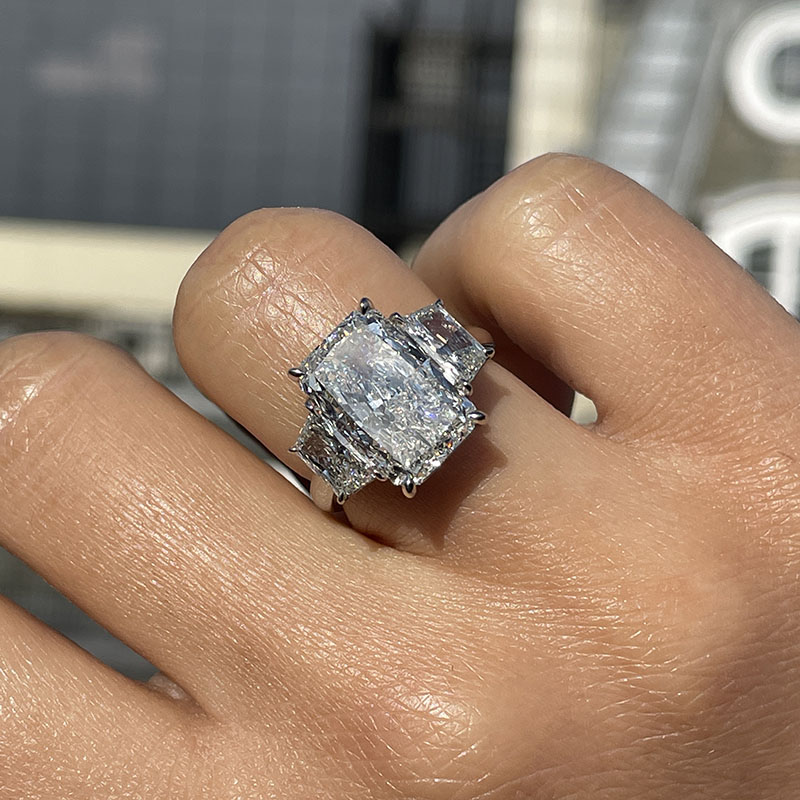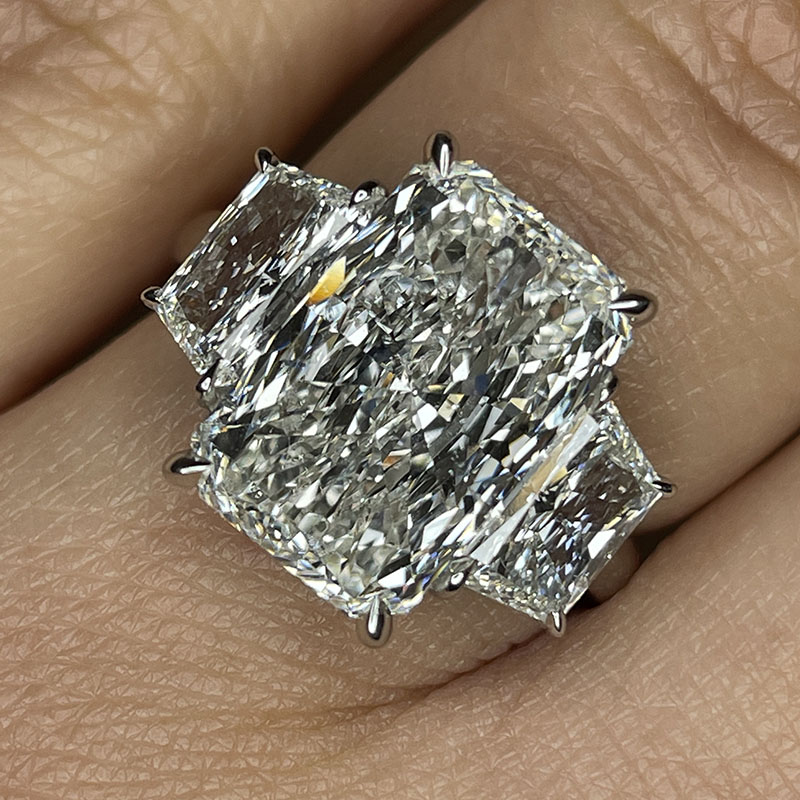In the dazzling world of diamonds, where brilliance, fire, and scintillation reign supreme, certain cuts capture attention not just for their inherent sparkle, but for their unique form and architectural grace. Among these distinctive shapes, the trapezoid cut diamond stands out as a sophisticated, often unsung hero. While not typically chosen as a center stone, its geometric precision and understated elegance make it an indispensable player in creating truly captivating jewelry designs, especially as an accent or side stone.
This article delves into the fascinating world of trapezoid cut diamonds, exploring their unique characteristics, facet patterns, the crucial role they play in various settings, and what makes them such a desirable choice for those seeking a blend of classic sophistication and modern aesthetics.
What is a Trapezoid Cut Diamond?
At its core, a trapezoid is a quadrilateral with at least one pair of parallel sides. In the context of diamonds, a trapezoid cut stone typically features four sides, with two parallel sides (the top and bottom) and two non-parallel, angled sides that taper inward or outward. This distinct geometric shape lends itself to a clean, architectural look that sets it apart from more traditional cuts like rounds or ovals.
Trapezoid cut diamonds are rarely seen as standalone engagement ring centerpieces. Instead, their true magic unfolds when they are strategically placed alongside a larger, often rectangular or square-shaped, center stone. Their tapered form allows them to seamlessly flank a central gem, creating a harmonious visual flow and enhancing its presence without overpowering it.
The Allure of Geometric Precision
The appeal of the trapezoid cut lies in its inherent sense of order and balance. Its straight lines and defined angles evoke a modern, minimalist aesthetic, yet it also possesses a timeless quality that harks back to the Art Deco era, where geometric forms were celebrated. This duality allows trapezoid diamonds to complement a wide range of styles, from contemporary designs to vintage-inspired pieces.
Unlike the fiery sparkle of a brilliant cut, trapezoids often exude a more subtle, sophisticated brilliance. They offer a "hall of mirrors" effect, producing broad flashes of light rather than numerous small scintillations. This elegant light play is a hallmark of their most common facet pattern: the step cut.
Facet Patterns: Step Cut vs. Brilliant Cut Trapezoids
The way a diamond is faceted dramatically influences its appearance and how it interacts with light. For trapezoid cut diamonds, two primary facet patterns are employed:
-
Step Cut Trapezoids:
This is by far the most prevalent and iconic facet pattern for trapezoid diamonds. Step cuts feature long, rectangular facets arranged in parallel rows, resembling steps or a staircase. This design emphasizes the diamond’s clarity and color, as it produces a mesmerizing "hall of mirrors" effect with broad, dramatic flashes of light. The lack of numerous small facets means that inclusions are more visible, making clarity a crucial consideration for step-cut trapezoids. Their elegance and clean lines perfectly complement emerald cut or radiant cut center stones, providing a harmonious visual extension. The light return from a step cut is more about elegant flashes than fiery sparkle, offering a sophisticated sheen that appeals to those who appreciate understated luxury. -
Brilliant Cut Trapezoids:
While less common, brilliant cut trapezoids do exist. These stones feature a complex arrangement of triangular and kite-shaped facets designed to maximize sparkle, fire, and scintillation. They are typically used when the goal is to match the intense sparkle of a brilliant cut center stone, such as a round brilliant or a cushion cut. Brilliant cut trapezoids will exhibit more scattered, fiery flashes of light compared to their step-cut counterparts. While they offer more sparkle, they may lose some of the distinct geometric precision that defines the trapezoid’s character. -
Mixed Cut Trapezoids:
In some instances, jewelers and cutters may opt for a mixed cut, combining elements of both step and brilliant faceting. This can be done to achieve a unique balance between the clean lines of a step cut and the enhanced sparkle of a brilliant cut, often customized to suit a specific design vision or to better match a center stone with a mixed facet pattern.
The Trapezoid as an Accent Stone: A Design Powerhouse
The true brilliance of the trapezoid cut diamond shines through its role as an accent or side stone. Its tapered shape is incredibly versatile, allowing it to seamlessly integrate into various jewelry designs:
-
Three-Stone Rings: This is arguably the most classic application for trapezoid diamonds. Flanking a rectangular or square center stone – such as an emerald cut, radiant cut, or even a cushion cut – two trapezoid diamonds create a stunning, symmetrical silhouette. They provide a graceful transition from the larger center stone to the band, making the center stone appear even grander and adding a sophisticated spread across the finger. The clean lines of step-cut trapezoids are particularly complementary to emerald cuts, creating a cohesive, architectural look.
-
Halo Settings: While not a traditional halo shape, trapezoids can be used in unique halo designs, especially around radiant or emerald cut center stones. Instead of a continuous circle of small round diamonds, a halo composed of strategically placed trapezoids can create a more angular, modern, and distinctive frame for the central gem.
-
Shoulder Stones and Side Accents: Beyond three-stone rings, trapezoids can be set along the shoulders of an engagement ring band, adding width and visual interest. They can also be incorporated into more intricate custom designs, serving as unexpected accents that elevate the overall aesthetic.
-
Unique Engagement Rings: For those seeking a truly bespoke piece, trapezoid diamonds can be used in more unconventional ways, perhaps in a bypass design where they meet at the center, or in abstract patterns that highlight their geometric charm.
Key Considerations When Choosing Trapezoid Cut Diamonds
Selecting trapezoid diamonds, especially as a matched pair, requires careful attention to several factors:
-
Matching (for Pairs): This is paramount. When purchasing a pair of trapezoid side stones, it is crucial that they match perfectly in terms of:
- Color: They should be within one color grade of each other and, more importantly, match the color of the center stone to avoid any jarring discrepancies.
- Clarity: Especially for step cuts, clarity is very important as inclusions are more easily visible. They should ideally be eye-clean.
- Proportions and Dimensions: The length-to-width ratio, the angle of the non-parallel sides, and the overall dimensions must be identical for a symmetrical and harmonious look when flanking a center stone. Even slight differences can be noticeable.
-
Cut Quality: While trapezoids don’t receive a formal cut grade from GIA like round brilliants, the quality of their cut is critical. Look for:
- Symmetry: Excellent symmetry is essential for a clean, balanced appearance.
- Polish: A high-quality polish enhances the diamond’s ability to reflect light, especially in step cuts where large facets are prominent.
- Proportions: Well-proportioned trapezoids will have an appealing outline and maximize light return. Avoid stones that are too shallow (leading to a "fisheye" effect) or too deep (resulting in a dark center).
-
Color: As accent stones, their color should ideally complement or be slightly better than the center stone. A perfectly matched color ensures a seamless transition.
-
Clarity: Given the open facets of step-cut trapezoids, inclusions are more apparent. Aim for a clarity grade that is "eye-clean" (no visible inclusions to the naked eye), typically VS1 or VS2, or higher.
-
Length-to-Width Ratio and Angles: The specific proportions and angles of the trapezoid will influence how it frames a center stone. Consider the shape of your center stone and how the trapezoids will visually extend it. Some trapezoids are more acutely angled, while others are wider, offering different design possibilities.
Styling and Design Inspiration
The versatility of trapezoid cut diamonds makes them suitable for a myriad of styles:
- Art Deco Revival: Their strong geometric lines are a natural fit for Art Deco-inspired jewelry, which celebrates symmetry, bold shapes, and architectural elegance.
- Modern Minimalism: In contemporary designs, a single trapezoid on each side of a clean emerald or radiant cut creates a sleek, sophisticated, and uncluttered look.
- Vintage Charm: Paired with antique-style settings or milgrain detailing, trapezoids can evoke a sense of old-world charm while maintaining a distinct silhouette.
- Custom Creations: Their unique shape offers endless possibilities for custom jewelry designers to craft truly one-of-a-kind pieces.
Why Choose a Trapezoid Cut Diamond?
Opting for trapezoid cut diamonds, whether as side stones or in a unique custom piece, offers several compelling advantages:
- Distinctive Elegance: They provide a unique aesthetic that sets your jewelry apart from more common designs.
- Enhance Center Stones: Their primary role is to magnify the beauty and presence of the central diamond, making it appear larger and more prominent.
- Geometric Appeal: For those who appreciate clean lines, symmetry, and architectural forms, the trapezoid cut is a perfect choice.
- Understated Sophistication: They offer a refined brilliance that is elegant and sophisticated, without being overtly flashy.
Conclusion
The trapezoid cut diamond, with its sharp angles and graceful taper, is a testament to the power of geometric design in fine jewelry. Far from being a mere accessory, it is a thoughtfully chosen element that can transform a beautiful piece into a breathtaking masterpiece. Its ability to seamlessly complement, enhance, and elevate a center stone, coupled with its timeless appeal and modern versatility, secures its position as a truly special and invaluable player in the world of diamonds. For those seeking to add a touch of sophisticated structure and understated brilliance to their jewelry, the geometric allure of the trapezoid cut diamond is an irresistible choice.


